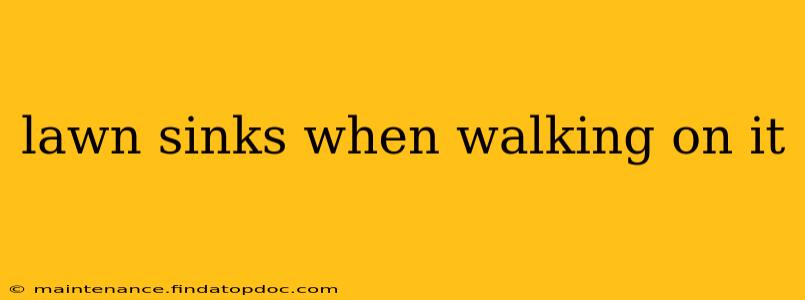Walking across your lawn and feeling it sink beneath your feet is frustrating and can indicate underlying soil problems. This issue, often referred to as soft or spongy soil, can ruin the aesthetic appeal of your yard and damage the health of your grass. Let's delve into the common reasons why your lawn might be sinking and explore effective solutions.
Why Does My Lawn Sink When I Walk On It?
This problem often stems from poor soil structure and compaction. Here are some key culprits:
-
Compacted Soil: Over time, soil can become compacted, reducing its ability to drain water effectively. Heavy foot traffic, machinery use, or even just the weight of the grass itself contributes to this compaction. Compacted soil lacks air pockets, which are essential for healthy root growth and proper water drainage. This leads to saturated soil that feels spongy or sinks under pressure.
-
Poor Drainage: If your soil doesn't drain well, water accumulates, creating a boggy, unstable surface. This is often exacerbated by heavy clay soils, which are naturally less permeable. Poor drainage can also be caused by improper grading, resulting in water pooling in certain areas.
-
Thatch Buildup: Thatch is the layer of dead and decaying organic matter that accumulates between the grass blades and the soil surface. Excessive thatch prevents water and air from reaching the soil, promoting compaction and creating a spongy feel.
-
Root Issues: A lack of healthy, deep roots can leave the soil unsupported. This can be due to various factors including poor soil health, insufficient nutrients, or diseases affecting the root system. Shallow-rooted grass doesn't bind the soil as effectively, making it more prone to sinking.
-
Underground Issues: In some cases, the sinking could be due to something below the surface, such as a damaged sewer line or a void in the soil. This is less common but should be considered if the problem is localized to a specific area.
What to Do If Your Lawn Sinks When You Walk On It?
Addressing the sinking lawn requires a multi-pronged approach focusing on improving soil health and drainage.
1. Aerate the Lawn
Aerating your lawn is crucial for breaking up compacted soil. This can be done with a core aerator, which removes small plugs of soil, creating channels for better air and water penetration. For smaller lawns, a garden fork can be used to create similar channels. Aerating is best done in spring or fall when the grass is actively growing.
2. Improve Drainage
If drainage is a major issue, consider installing a French drain or improving the grading of your lawn to direct water away from problem areas. Adding organic matter like compost to improve soil structure can also enhance drainage.
3. Dethatch the Lawn
If there’s excessive thatch buildup, dethatching is necessary. This can be done with a specialized dethatching rake or a power dethatcher. However, be cautious not to remove too much thatch, as it provides some beneficial insulation and organic matter.
4. Amend the Soil
Improving soil structure is paramount. Adding organic matter like compost or well-rotted manure enriches the soil, improves drainage, and promotes healthy root growth. This helps bind the soil particles together, making the lawn more stable.
5. Water Appropriately
Proper watering techniques are crucial. Water deeply and less frequently to encourage deep root growth. Avoid overwatering, as this can contribute to saturated soil and further compaction.
6. Reduce Foot Traffic
Try to minimize foot traffic on areas where the lawn is sinking. Consider creating pathways or walkways to divert foot traffic to areas that can better handle it.
7. Consider Soil Testing
A soil test can reveal nutrient deficiencies or other problems that may be contributing to poor soil health and the sinking lawn. Based on the results, you can then amend the soil with the appropriate fertilizers or other treatments.
How Can I Prevent My Lawn from Sinking in the Future?
Prevention is key! Regular aeration, proper fertilization, and appropriate watering practices are crucial. Avoid heavy machinery use on your lawn whenever possible. Maintaining healthy soil is the best long-term solution to prevent this issue.
By addressing the underlying causes and implementing these solutions, you can restore the health and stability of your lawn, preventing it from sinking underfoot. Remember, consistency is key—regular maintenance will keep your lawn thriving for years to come.
